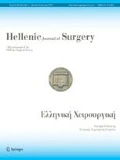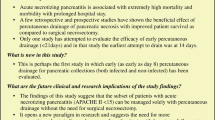Abstract
Introduction
Acute necrotising pancreatitis (NP) is associated with high morbidity and mortality. Patients with infected pancreatic necrosis (IPN) require some form of intervention in addition to medical management. Although there is no accepted consensus, it is generally agreed that the infected non-vital solid tissue needs to be removed in order to control the sepsis. The results of early surgery have not been encouraging, compared with cases where surgery was delayed or avoided. The placement of percutaneous catheter drains in such a situation helps to decrease the systemic inflammatory response and reverse organ dysfunction.
Aims and objectives
The aim of this study was to review retrospectively the results of percutaneous catheter drainage (PCD) in patients with acute NP requiring intervention.
Materials and methods
A retrospective study was conducted of patients presenting with acute NP from March 2012 to June 2015. Demographic, clinical, and perioperative information was retrieved from the medical records. The patients were initially managed in the intensive care unit (ICU) with goal-directed therapy and organ support where indicated. The patients with IPN and few with sterile pancreatic necrosis (SPN) who had persistent organ failure or whose clinical condition was deteriorating despite adequate medical support were subjected to some form of intervention. All the patients requiring PCD or surgical intervention were included in this study. These patients were divided into 3 groups based on the type of intervention: a) PCD only, b) PCD followed by surgical intervention, and (c) surgery alone. The outcome in these 3 groups was analyzed and the factors associated with failure of PCD were identified. In addition, the complications of SPN were investigated.
Results
The records were reviewed of 46 patients diagnosed with acute NP, of which 23 required PCD or surgical intervention and were included in this study. The mean acute physiology and chronic health (APACHE II) score of these patients was 10.6 ± 3.45, while the mean bedside index of severity in acute pancreatitis (BISAP) score was 4.47 ± 0. 53. On contrast enhanced computed tomography (CECT) scan of the abdomen, 39% of the patients had >50% necrosis, with a mean CT severity index (CTSI) of 8.1 ± 1.9. Of the 21 patients treated initially with PCD, a step-up approach was applied in 8 patients, because of failure of PCD. The mean duration from admission to intervention was 19.5 days. A mean of 2.4 pigtail catheters were placed in each patient. Additional drains were placed in 3 patients. The duration of PCD ranged from 20 to 124 days. The mean ICU stay was 14.3 ± 3.2 days and the mean hospital stay was 35.8 ± 7.4 days. Post-intervention complications were recorded in 11 (47.8%) patients, of which 2 patients with PCD developed an external pancreatic fistula and 2 had bleeding. The mortality rate was 26% (6 patients).
Conclusion
PCD is a feasible and successful modality of treatment for acute NP requiring intervention. With the use of PCD, surgical necrosectomy may be completely avoided or delayed until the condition of the patient is stable enough to sustain surgery.
Similar content being viewed by others
References
Becker JM, Pemberton JH, DiMagno EP, Ilstrup DM, McIlrath DC, et al. Prognostic factors in pancreatic abscess. Surgery 1984; 96: 455–460.
Bradley EL 3 rd. A clinical based classification system for acute pancreatitis. Summary of the International Symposium on Acute Pancreatitis, Atlanta Ga, September 11-13 1992. Arch Surg 1993; 128: 586–590.
Werner J, Feuerbach S, Uhl W, Büchler MW. Management of acute pancreatitis: from surgery to interventional intensive care. Gut 2005; 54: 426–436.
Bruennler T, Langgartner J, Lang S, Wrede CE, Klebl F, et al. Outcome of patients with acute, necrotizing pancreatitis requiring drainage does drainage size matter? World J Gastroenterol 2008; 14: 725–730.
Beger HG, Rau BM. Severe acute pancreatitis: Clinical course and management. World J Gastroenterol 2007; 13: 5043–5051.
Baril NB, Ralls PW, Wren SM, Selby RR, Radin R, et al. Does an infected peripancreatic fluid collection or abscess mandate operation? Ann Surg 2000; 23: 361–367.
McFadden DW, Reber HA. Indications for surgery in severe acute pancreatitis. Int J Pancreatol 1994; 15: 83–90.
Nieuwenhuijs VB, Besselink MG, van Minnen LP, Gooszen HG. Surgical management of acute necrotizing pancreatitis: a 13-year experience and a systematic review. Scand J Gastroenterol Suppl 2003; 239: 111–116.
Götzinger P, Wamser P, Exner R, Schwanzer E, Jakesz R, et al. Surgical treatment of severe acute pancreatitis: timing of operation is crucial for survival. Surg Infect 2003; 4: 205–211.
Mier J, León EL, Castillo A, Robledo F, Blanco R. Early versus late necrosectomy in severe necrotizing pancreatitis. Am J Surg 1997; 173: 71–75.
Zerem E, Imamovic G, Omerovic S, Imširovic B. Randomized controlled trial on sterile fluid collections management in acute pancreatitis: should they be removed? Surg Endosc 2009; 23: 2770–2777.
Besselink MG, Verwer TJ, Schoenmaeckers EJ, Buskens E, Ridwan BU, et al. Timing of surgical intervention in Timing of surgical intervention in necrotizing pancreatitis. Arch Surg 2007; 142: 1194–1201.
Zerem E. Reply to: Draining sterile fluid collections in acute pancreatitis? Primum non nocere! Surg End 2009; 25: 979–980.
Besselink MG, van Santvoort HC, Nieuwenhuijs VB, Boermeester MA, Bollen TL, et al. Minimally invasive ‘step-up approach’ versus maximal necrosectomy in patients with acute necrotizing pancreatitis (PANTER trial): design and rationale of a randomized controlled multicenter trial [ISRCTN13975868]. BMC Surg 2006; 6:6.
Horvath K, Freeny P, Escallon J, Heagerty P, Comstock B, et al. Safety and efficacy of video-assisted retroperitoneal debridement for infected pancreatic collections: a multicenter, prospective, single-arm phase 2 study. Arch Surg 2010; 145: 817–825.
Zerem E, Imamovic G. Comments on the article about the treatment of peripancreatic infection. World J Gastroenterol 2010; 16: 2321–2322.
van Santvoort HC, Besselink MG, Bakker OJ, Hofker HS, Boermeester MA, et al. A step-up approach or open necrosectomy for necrotizing pancreatitis. N Engl J Med 2010; 362: 1491–1502.
Zerem E, Imamovic G, Sušic A, Haracic B. Step-up approach to infected necrotising pancreatitis: a 20-year experience of percutaneous drainage in a single centre. Dig Liver Dis 2011; 43: 478–483.
Besselink MG. The ‘step-up approach’ to infected necrotizing pancreatitis: Delay, drain, debride. Dig Liver Dis 2011; 43: 421–422.
Van Baal MC, van Santvoort HC, Bollen TL, Bakker OJ, Besselink MG et al. Systemic review of percutaneous catheter drainage as primary treatment for necrotizing pancreatitis. Br J Surg 2011; 98: 18–27.
Venigalla Pratap Mouli, Vishnubhatla Sreenivas, Pramod Kumar Garg. Efficacy of Conservative Treatment, Without Necrosectomy, for Infected Pancreatic Necrosis: A Systematic Review and Meta-analysis. Gastroenterology 2013; 144(2): 333–340.
Windsor JA. Infected pancreatic necrosis: drain first but do it better. HPB (Oxford) 2011;13:367–368.
Navaneethan U, Vege SS, Chari ST, Baron TH. Minimally invasive techniques in pancreatic necrosis. Pancreas 2009;38:867–875.
Banks PA. Practice guidelines in acute pancreatitis. Am J Gastroenterol 1997; 92: 377–386.
Büchler MW, Gloor B, Müller CA, Friess H, Seiler CA, et al. Acute necrotizing pancreatitis: treatment strategy according to the status of infection. Ann Surg 2000; 232: 619–626.
Connor S, Raraty MG, Howes N, Evans J, Ghaneh P, et al. Surgery in the treatment of acute pancreatitis—minimal access pancreatic necrosectomy. Scand J Surg 2005; 94: 135–142.
Chen GY, Dai RW, Luo H, et al. Effect of percutaneous catheter drainage on pancreatic injury in rats with severe acute pancreatitis induced by sodium taurocholate. Pancreatology. 2015;15:71–7.
Wang T, Liu LY, Luo H, et al. Intra-Abdominal Pressure Reduction After Percutaneous Catheter Drainage Is a Protective Factor for Severe Pancreatitis Patients with Sterile Fluid Collections. Pancreas. 2016;45:127–33.
Author information
Authors and Affiliations
Corresponding author
Rights and permissions
About this article
Cite this article
Dronacharya, R., Naidu, C., Singh, A. et al. Staying the Surgeon’s Hand: Role of Percutaneous Catheter Drainage in Acute Necrotising Pancreatitis. Hellenic J Surg 90, 16–21 (2018). https://doi.org/10.1007/s13126-018-0429-3
Received:
Accepted:
Published:
Issue Date:
DOI: https://doi.org/10.1007/s13126-018-0429-3




